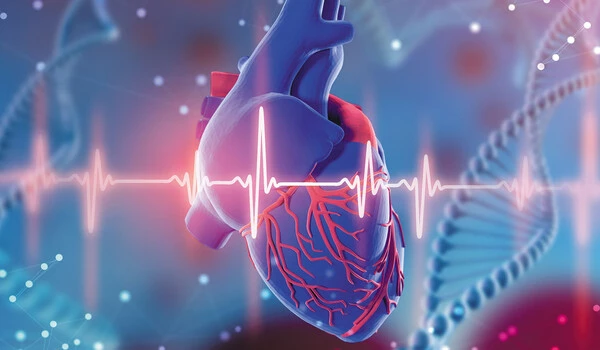Genetic variants associated with an increased risk of developing DCM have been reported in both humans and dogs, including Dobermanns. These mutations can affect the normal functioning of proteins involved in heart muscle contraction, leading to the disease’s development.
Researchers made an important discovery in determining the genetic basis of dilated cardiomyopathy in Dobermanns. This research advances our understanding of the genetic risk factors for deadly heart muscle illnesses, as well as the mechanisms underlying the disease, and provides novel approaches for their prevention.
Researchers from the University of Helsinki and the Folkhälsan Research Center, in collaboration with international collaborators, have found the genetic basis of dilated cardiomyopathy, a condition that enlarges the heart muscle, in dogs and humans.
Based on a dataset of over 500 Dobermanns, the condition was linked to two neighboring chromosomal regions where alterations in genes affecting heart muscle function, energy consumption, and structure were discovered. The study discovered that the same risk genes induce cardiac muscle dysfunction in human patients.
We discovered how the two gene variants work together to increase disease risk. However, a pilot study is required to combine genetic and health data in order to track how frequently individuals in the at-risk group get the disease for various hereditary reasons.
Professor Hannes Lohi
Cardiomyopathy can be caused by a number of circumstances, although genetics play a key impact. Although scores of genes have been identified as causing cardiomyopathy in humans, the hereditary nature and genetic background of the disease in dogs remain unknown.
“The situation with Dobermanns is critical in terms of both health and breeding. For decades, the disease has been examined from many perspectives with no important gene discoveries. Better diagnostic tools are required, especially in early diagnosis. “Our new research could help,” says the project’s senior investigator, Professor Hannes Lohi.
The work has important significance for veterinary medicine since it provides a foundation for the development of a novel genetic test for early diagnosis and breeding.

Two novel risk genes identified in an extensive European cohort
Various research data collected over decades on more than 500 Dobermanns from across Europe were combined for the research. The dogs in the study cohort were categorized into five different groups:
- Dogs with only dilated cardiomyopathy
- Dogs with only arrhythmia
- Dogs with dilated cardiomyopathy and arrhythmia
- Dogs with congestive heart failure
- Healthy dogs aged at least six years as a control subcohort
With the help of genetic mapping, two adjacent gene loci in chromosome 5 were associated with dilated cardiomyopathy. Among the numerous genes in the loci, two, namely RNF207 and PRKAA2, demonstrated structural variation, which could have a detrimental effect on the functioning of the genes and cause heart failure.
“We made important discoveries as a result of our genetic mapping. Until today, it was unclear whether Dobermanns with varying symptoms were suffering from the same condition. The genes we discovered are solely linked to a dilated heart and have an effect on cardiac function. Arrhythmia appears to be a separate hereditary illness. Our dataset was insufficient to identify solely arrhythmia-causing genes. “We also discovered that several genes influence cardiac function and identified a model of two genes that increase disease risk,” Professor Lohi continues.
Gene discovery in dogs associated with cardiac muscle disorders in humans
The importance of gene discovery in dogs was examined in human patients with dilated cardiomyopathy utilizing cohorts from the Netherlands, England (UK Biobank), and Finland (FinnGen). In humans, fifteen potentially detrimental and predisposing variations in the RNF207 and PRKAA2 genes that had previously been found in dogs were detected.
“The identical genetic background suggests that, to some extent, similar problems with heart muscle function lead to dilated cardiomyopathy in both humans and dogs. A better understanding of pathogenetic mechanisms is critical, and Dobermanns are a natural model organism for future research,” says Lohi.
A genetic test for breeding
The DNA markers associated with the condition discovered in the study may be a step toward a genetic test, but clinical importance must be confirmed before such tests are offered.
“We discovered how the two gene variants work together to increase disease risk. However, a pilot study is required to combine genetic and health data in order to track how frequently individuals in the at-risk group get the disease for various hereditary reasons. Then we can get a better idea of how the gene findings should be best evaluated and used. In any event, this is a heartening discovery because, in the past, we lacked such instruments,” Lohi says.
The new gene discoveries enable new research hypotheses
For the consistent synchronized pumping of the heart, the heart muscle cells must interact with each other. Unlike in skeletal muscles, in the cell membrane of the heart muscle are finger-like discs that conduct the undulation required for pumping.
“Our findings show that the RNF207 gene is expressed specifically in these discs.” RNF207 has previously been shown to have a crucial function in heart muscle contraction. Previously, the absence of these discs was associated with cardiomyopathy. The other discovered gene, PKAA2, functions as an energy sensor in the heart muscle, and its failure can diminish cardiac efficiency. More research is needed to understand the pathogenic process, but we are well-positioned to proceed. “A few years ago, the disease was completely unknown, but now we have a window into its cellular-level secrets,” Professor Lohi says.
















